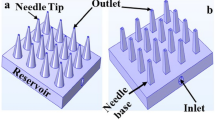Abstract
This article considers the simulation and optimization of transdermal drug transport from systems of solvable microneedles. A two-dimensional problem of vertical transport of solvable drugs through a porous medium with point sources imitating solvable microneedles is solved. It is shown that, by controlling the intensity and specifying the coordinates of the sources, the problem of optimal control of transdermal drug transport can be solved and a desired distribution of drugs in epidermis can be achieved with acceptable accuracy. To solve initial-boundary value problems, finite-difference methods and a two-step symmetrizable algorithm are used.
Similar content being viewed by others
References
S. Kaushik, A. H. Hord, D. D. Denson, et al., “Lack of pain associated with microfabricated microneedles,” Anesth. Analg., Vol. 92, 502–504 (2001).
R. K. Sivamani, B. Stoeber, G. C. Wu, et al., “Clinical microneedle injection of methylnicotinate: Stratum corneum penetration,” Skin Res. Tech., Vol. 11, No. 11, 152–156 (2005).
M. R. Prausnitz, S. Mitragotri, and R. Langer, “Current status and future potential of transdermal drug delivery,” Nat. Rev. Drug. Discov., Vol. 3, 115–124 (2004).
J. W. Lee, S.-O. Choi, E. I. Felner, and M. R. Prausnitz, “Dissolving microneedle patch for transdermal delivery of human growth hormone,” Small, Vol. 7, 531–539 (2001).
S. P. Sullivan, N. Murthy, and M. R. Prausnitz, “Minimally invasive protein delivery with rapidly dissolving polymer microneedles,” Adv. Mater., Vol. 20, 933–938 (2008).
S. F. Lahiji, M. Dangol, and H. Jung, “A patchless dissolving microneedle delivery system enabling rapid and efficient transdermal drug delivery,” Scientific Reports, Vol. 5 (2015). Article Number: 7914. DOI:10.1038/srep07914. URL: http://www.nature.com/articles/srep07914.
K. Ita, “Transdermal delivery of drugs with microneedles — potential and challenges,” Pharmaceutics, Vol. 7, No. 3, 90–105 (2015).
Y. N. Kalia and R. H. Guy, “Modeling transdermal drug release,” Adv. Drug Deliv. Rev., Vol. 48, 159–172 (2001).
J. E. Rim, P. M. Pinsky, and W. W. Van Osdol, “Finite element modeling of coupled diffusion with partitioning in transdermal drug delivery,” Ann. Biomed. Eng., Vol. 33, 1422–1438 (2005).
B. Al-Qallaf, D. B. Das, D. Mori, Z. Cui, “Modelling transdermal delivery of high molecular weight drugs from microneedle systems,” Phil. Trans. R. Soc. A., Vol. 365, 2951–2967 (2007).
B. Al-Qallaf and D. B. Das, “Optimization of square microneedle arrays for increasing drug permeability in skin,” Chemical Engineering Science, Vol. 63, No. 9, 2523–2535 (2008).
O. Olatunji, D. B. Das, and V. Nassehi, “Modelling transdermal drug delivery using microneedles: Effect of geometry on drug transport behaviour,” J. Pharm. Sci., Vol. 101, No. 1, 164–175 (2012).
D. A. Klyushin, N. I. Lyashko, and Yu. N. Onopchuk, “Mathematical modeling and optimization of intratumor drug transport,” Cybernetics and Systems Analysis, Vol. 43, No. 6, 886–892 (2007).
S. I. Lyashko, Generalized Optimal Control of Linear Systems with Distributed Parameters, Kluwer, Amsterdam (2002).
N. I. Lyashko, A. E. Grishchenko, and V. V. Onotskii, “A regularization algorithm for singular controls of parabolic systems,” Cybernetics and Systems Analysis, Vol. 42, No. 1, 75–82 (2006).
S. I. Lyashko and D. A. Nomirovskii, “Generalized solutions and optimal controls in systems describing the dynamics of a viscous stratified fluid,” Differential Equations, Vol. 39, No. 1, 90–98 (2003).
S. I. Lyashko and V. V. Semenov, “Controllability of linear distributed systems in classes of generalized actions,” Cybernetics and Systems Analysis, Vol. 37, No. 1, 13–32 (2001).
D. A. Klyushin, S. I. Lyashko, D. A. Nomirovsky, Yu. I. Petunin, and V. V. Semenov, Generalized Solutions of Operator Equations and Extreme Elements, Springer, New York–Dordrecht–Heidelberg–London (2012).
S. I. Lyashko, D. A. Klyushin, D. A. Nomirovsky, and V. V. Semenov, “Identification of age — structured contamination sources in ground water,” in: Optimal Control of Age — Structured Populations in Economy, Demography, and the Environment, R. Boucekkline et al. (eds.), Routledge, London–New York (2010).
Author information
Authors and Affiliations
Corresponding author
Additional information
*This work was financially supported by the Ministry of Education and Science of Ukraine (theme No. DR 0116U004777) and State Fund for Fundamental Research of Ukraine (project F74/24921).
Translated from Kibernetika i Sistemnyi Analiz, No. 3, May–June, 2017, pp. 17–26.
Rights and permissions
About this article
Cite this article
Lyashko, S.I., Klyushin, D.A., Onotskyi, V.V. et al. Optimal Control of Drug Delivery from Microneedle Systems*. Cybern Syst Anal 54, 357–365 (2018). https://doi.org/10.1007/s10559-018-0037-9
Received:
Published:
Issue Date:
DOI: https://doi.org/10.1007/s10559-018-0037-9




